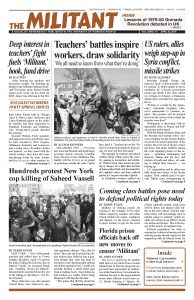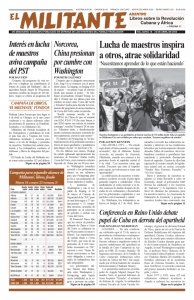President Donald Trump is continuing the trend of previous administrations of tightening control of the border with Mexico and increasing criminal penalties for workers without papers. At the same time his administration has expanded the number of workers that can enter the country on temporary visas.
The Trump administration has increased “sweeps,” where immigration cops target workers they want to deport on the street or in their homes, often picking up others who happen to be there at the time, and U.S. Immigration and Customs Enforcement agents organized the first major factory raid in 10 years.
On April 5 ICE, along with the Internal Revenue Service and state police, carried out a major factory raid. They surrounded the Southeastern Provision meatpacking plant in Bean Station, Tennessee, and arrested 97 workers. The plant was raided after police learned that the bosses were paying many workers in cash and had reported to the IRS that there were only 44 employees.
The George W. Bush administration ended large-scale factory raids in 2008, after almost every raid was met by protests against deportations. U.S.-born workers often helped their fellow workers without papers to hide or escape from the immigration police.
These measures need to be answered by the labor movement with protests demanding an end to deportations and calling for amnesty for immigrants. This is a life and death question for the trade unions.
Trump is also pushing changes that would make it harder for migrants seeking asylum, especially women and children from Central America, to get permission to enter the country. But nothing that the White House put in place is a radical departure from the course of previous administrations.
The president’s anti-immigrant demagogy is aimed at dividing the working class. At an April 5 speech in West Virginia, Trump referred to a caravan of Hondurans traveling through Mexico, with hopes of entering the U.S. He claimed that on the caravan “women are raped at levels that nobody has ever seen before.” Then he added, “This is the kind of stuff and crap that we’re allowing into our country, and we can’t do it.”
The same day the president authorized sending up to 4,000 National Guard troops to the Mexican border “until we can have a wall and proper security.” It’s up to the governor of each state asked to participate whether or not to send the guardsmen, which would be funded by the federal government only until the end of September.
Not the first time
President Bush sent 6,000 National Guard troops to the border with Mexico from 2006 to 2008 and President Barack Obama sent 1,200 from 2010 to 2011. As of April 7 only Arizona and Texas have responded, saying they will start with 400 Guard members. According to the memo approved by Defense Secretary James Mattis, the troops will not perform law enforcement functions or “interact with migrants or other persons detained.”
On April 6 President Trump directed ICE to quickly report to him on what the agency is doing to end what he calls “catch and release.” The same day Attorney General Jeff Sessions said he was ordering U.S. Attorney’s Offices in the Southwest to bring charges against first-time offenders accused of illegal entry before they are deported so that if they get caught again they can be charged with the felony of illegal re-entry and sent to prison.
In fact, since 2011 the overwhelming majority of those picked up by the immigration cops are already subject to deportation under the equivalent of a judicial order and to felony charges and jail time if they are caught again.
Despite claims by President Trump that there is a new crisis at the U.S.-Mexico border, the number of people deported by ICE declined every year from 2005 to 2017, a reflection of the lower numbers trying to cross into the U.S. without official travel documents. This has been due to years of high unemployment.
With Trump’s election the monthly figure reached a new low. But by December the figure had risen to the level it was when Obama left office. But the administration is still deporting fewer immigrants than Obama did in his first years in office.
U.S. capitalists depend on immigrant labor to compete with their rivals around the world. Their goal is not to deport all immigrants but to intensify competition among workers and maintain a pariah layer of the working class, forced to accept lower wages and harsher work conditions who live in fear of deportation and won’t speak out. This pushes down wages for the working class as a whole.
At the same time that the White House is cranking up anti-immigrant rhetoric, it has quietly continued the trend to increase the number of H-2A “guest” visas for farmworkers. More than 200,000 were approved for 2017, up from 134,368 the year before. Farmworkers with these temporary visas can be rapidly deported if they quit or are fired.
Even with the increase, big capitalist farmers are still complaining that there is a labor shortage at the wages they are willing to pay.
The Republican-led government in Colorado decided March 23 to make it easier for undocumented workers to apply for driver’s licenses. With the current uptick in the economy bosses there are keen to ensure that the workers they hire can get to work.

